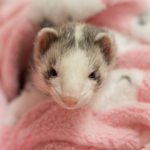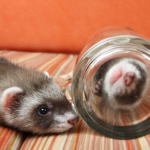Ferrets are playful, curious, and incredibly social pets that have captivated animal lovers for centuries. But did you know that ferrets come in a variety of breeds and colors? While all domesticated ferrets belong to the same species (Mustela putorius furo), the diversity in ferret breeds and colors results in unique coat patterns, body types, and personality traits.
In this guide, we’ll explore the fascinating world of ferret breeds and colors, highlighting their unique traits and helping you choose the perfect ferret for your home. Whether you’re a first-time owner or an experienced ferret enthusiast, this article will help you understand the different types of ferrets and what makes each one special.
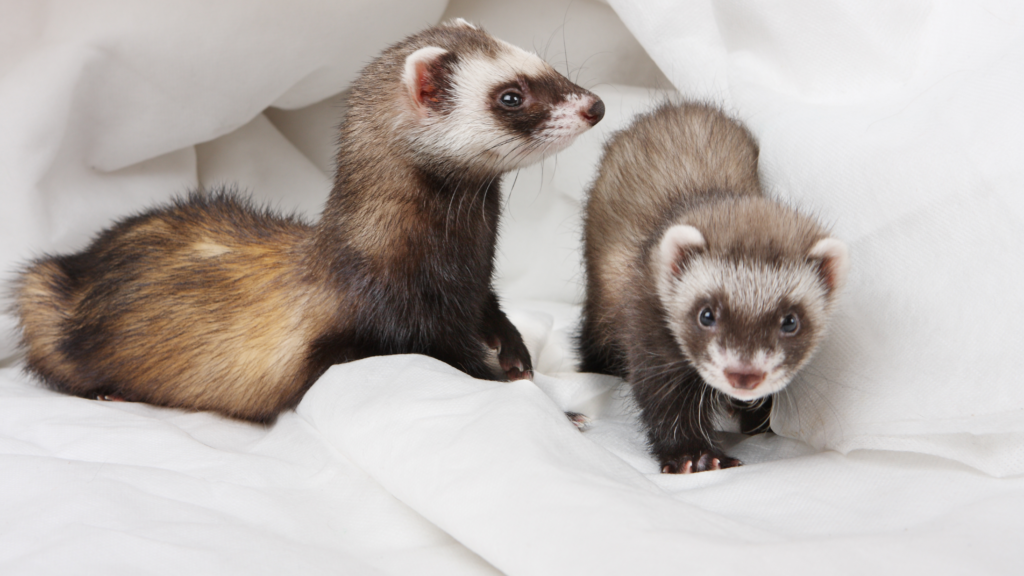
Understanding Ferret Breeds & Types
Are There Different Ferret Breeds?
When people think of pet ferrets, they often assume there are multiple breeds, just like with dogs or cats. However, this is a common misconception. All domesticated ferrets (Mustela putorius furo) belong to the same species, meaning there aren’t distinct breeds in the way we see with other pets. Instead of breed variations, ferrets are categorized based on their coat color, pattern, and body type.
So why do ferrets look so different from one another? The answer lies in selective breeding. Over time, breeders have focused on producing ferrets with unique coat colors, markings, and even fur length, leading to a wide variety of appearances. But no matter how different a ferret may look—from a sleek black sable to a fluffy Angora—they all share the same genetic background and general personality traits.
Ferret varieties are typically classified in three ways: color, coat type, and body structure. Color variations range from albino to chocolate, while coat types can be short-haired or long-haired (such as the Angora ferret). Some ferrets have distinct markings, like the panda or blaze patterns, while others have unique body builds, such as the slender “whippet” ferrets or the larger European hybrids. While these classifications help ferret lovers identify their pets’ unique traits, they don’t indicate separate breeds. No matter their appearance, all ferrets share the same playful, mischievous nature that makes them such fun companions!
Ferret Breeds and Colors: Coat Variations and Markings
One of the most exciting aspects of ferret breeds and colors is the wide variety of shades and markings that make each ferret truly unique. While they all share the same species, their coats can vary dramatically based on genetics. Let’s take a closer look at the most common ferret colors and markings!
Standard Ferret Colors
Albino Ferret
Albino ferrets are instantly recognizable by their snow-white fur and striking red or pinkish eyes. Their lack of pigmentation is due to a recessive gene, meaning both parents must carry the trait for an albino kit to be born. Despite their ghostly appearance, albino ferrets are just as playful and energetic as their darker-colored counterparts. However, they may be more sensitive to bright light due to their lack of eye pigmentation.
Black Ferret
Black ferrets have a deep, almost jet-black coat, often with a glossy sheen. Some may appear more dark brown under certain lighting, but true black ferrets have little to no lighter fur mixed in. Their dark coats make them look especially sleek and striking, and they often have a bold personality to match.
Chocolate Ferret
Chocolate ferrets are a beautiful, rich brown shade, often resembling the color of milk chocolate. They have warm undertones and typically lighter markings on their face, belly, or feet. Their eyes are usually dark, and their noses may range from pinkish to brown. Chocolate ferrets are one of the more common color variations seen in domesticated ferrets.
Cinnamon Ferret
Cinnamon ferrets have a light reddish-brown coat, sometimes with a golden or coppery tint. They are considered a rarer color variation, and their fur may lighten or darken with age. Their unique coloring makes them highly sought after among ferret enthusiasts.
Champagne Ferret
Champagne ferrets have a soft, diluted brown color that gives them a creamy beige appearance. This color is sometimes mistaken for chocolate but is significantly lighter. Their eyes can range from light brown to pinkish, and their nose is often a pale beige or light pink. This gentle hue gives them an elegant look, making them a favorite among ferret owners.
Ferret Patterns & Markings
Sable Ferrets
Sable ferrets are among the most common, characterized by a dark mask around their eyes and darker fur on their legs and tail. Their coat color can range from light brown to deep chocolate, and they often resemble wild polecats due to their markings.
Panda Ferrets
Panda ferrets have a distinctive appearance, with a fully white head and dark markings on the rest of their body. They often have white “mitts” on their feet and a pink nose. This striking pattern is highly sought after, but it’s important to note that some panda ferrets are prone to congenital deafness, similar to certain white-coated dog breeds.
Blaze Ferrets
Blaze ferrets are known for the white stripe that runs down the center of their head, resembling a blaze of light. They may also have white feet and a white bib on their chest. Like panda ferrets, many blaze-patterned ferrets are more susceptible to deafness due to genetic factors.
Mitted Ferrets
Mitted ferrets are easy to spot thanks to their white paws, which look like tiny mittens. This pattern can appear in many color variations, from sable to chocolate, and adds a charming touch to their overall look. Some mitted ferrets also have a white bib on their chest, enhancing their adorable appearance.
Point Ferrets (Siamese)
Point ferrets, sometimes referred to as Siamese ferrets, have darker coloration on their face, tail, and legs while the rest of their body remains lighter. This gradient-like effect makes them resemble Siamese cats, hence the name. Their darker points tend to deepen as they age, creating a striking contrast over time.
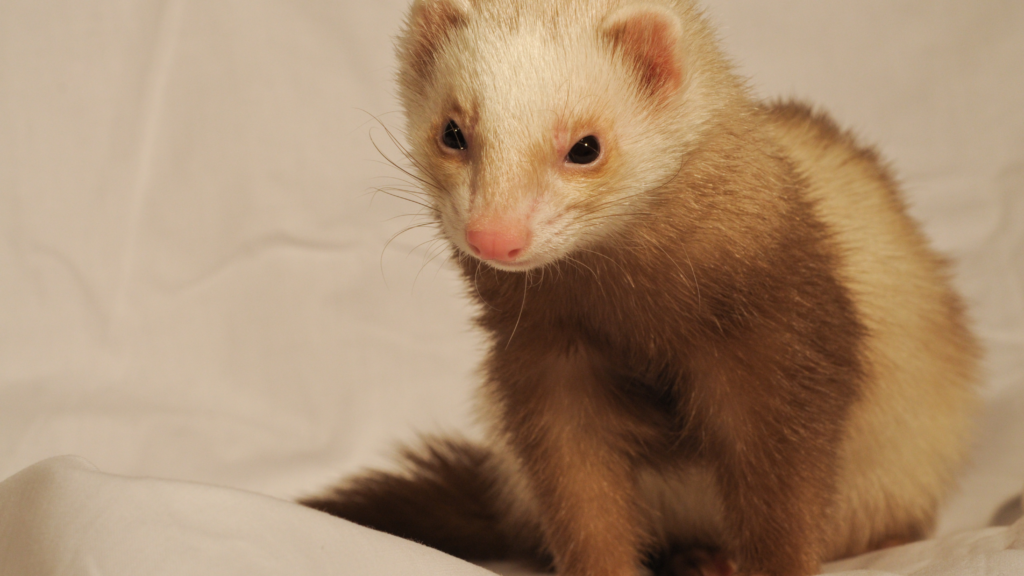
Ferret Coat Types & Fur Variations
Just like their playful personalities, ferrets’ coats can be surprisingly diverse. While most ferrets have short, sleek fur, others boast luxurious, long-haired coats that require extra care. Understanding these fur variations is essential for choosing the right ferret and ensuring proper grooming and maintenance. Whether you’re drawn to the low-maintenance appeal of a short-haired ferret or the fluffy elegance of an Angora, each coat type comes with its own set of benefits and challenges. Let’s explore the differences between short-haired and long-haired ferrets and take a closer look at the stunning Angora variety.
Short-Haired vs. Long-Haired Ferrets
Among ferret breeds and colors, short-haired ferrets are the most common and require minimal grooming. Their sleek coats require minimal maintenance, making them an excellent choice for first-time owners. These ferrets naturally shed twice a year—once in the spring and again in the fall—allowing them to adjust to seasonal temperature changes. While their shedding can be noticeable, it’s usually manageable with occasional brushing and a clean living environment. Short-haired ferrets are also a better option for allergy-prone owners since they tend to produce less dander than their long-haired counterparts.
On the other hand, long-haired ferrets, such as Angoras, have an eye-catching, plush coat that requires extra care. They shed more frequently and can develop matting if not groomed properly. Long-haired ferrets benefit from regular brushing, ideally a few times a week, to keep their fur soft and tangle-free. Owners should also check for debris or food getting caught in their long fur, especially around their face and paws. While these fluffy ferrets may demand a bit more maintenance, their striking appearance and soft coats make them a favorite among ferret enthusiasts.
So, which coat type is best? If you’re looking for a low-maintenance pet, a short-haired ferret is the way to go. But if you’re willing to put in extra grooming time, long-haired ferrets offer a truly unique and beautiful look. Either way, both coat types require regular hygiene and attention to keep your ferret happy and healthy.
Angora Ferrets – The Long-Haired Beauties
Angora ferrets are the royalty of the ferret world, known for their incredibly thick, long, and fluffy fur. Unlike standard long-haired ferrets, Angoras were selectively bred to have a distinctively longer coat, often growing up to three inches in length. This luxurious fur gives them a majestic, almost plush-like appearance that sets them apart from other ferrets. Some Angoras also have an extra tuft of fur on their nose, adding to their unique charm.
But with great beauty comes great responsibility. Angora ferrets require a strict grooming routine to prevent matting and excessive shedding. Their dense fur can trap dust, food particles, and even bedding, which means regular brushing is a must. A fine-toothed comb or a soft bristle brush works best to keep their coat smooth and free of tangles. Bathing should be kept to a minimum—only when necessary—since frequent washing can strip their fur of natural oils, leading to dryness and irritation.
Additionally, Angoras tend to shed more than standard ferrets, which can make them a challenge for allergy sufferers. Their thick fur may also lead to hairballs, so it’s essential to provide a proper diet rich in fiber to help with digestion. While they require more upkeep, many owners find the extra grooming time a small price to pay for their stunning appearance. If you’re looking for a ferret with an elegant, eye-catching coat and don’t mind the extra care, an Angora ferret might be the perfect companion for you!
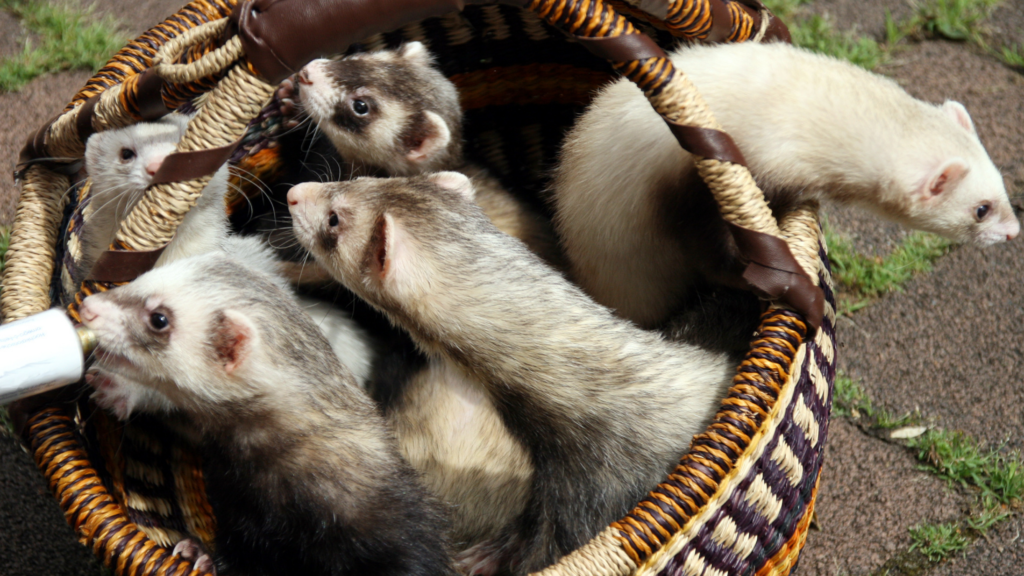
Ferret Body Types: Differences in Size & Build
Ferrets may all share the same playful and mischievous nature, but their body types can vary significantly depending on their lineage. While all domesticated ferrets belong to the same species (Mustela putorius furo), selective breeding has led to distinct differences in size, weight, and build. Some ferrets have a sturdy, stocky frame, while others are long and slender, built for speed and agility. These differences are primarily seen in three main categories: Standard (American) Ferrets, European (Hybrid) Ferrets, and Whippet (Slender) Ferrets. Each has its own unique characteristics, which can influence everything from their energy levels to their dietary needs. Let’s take a closer look at what makes each body type special.
Standard (American) Ferrets
Among the many ferret breeds and colors, the Standard (American) ferret is the most commonly found in pet stores across the United States. These ferrets have a balanced, medium-sized build with a proportionate length and weight. On average, they measure between 14 to 18 inches long (including the tail) and typically weigh between 1 to 4 pounds, with males being noticeably larger than females.
American ferrets have a compact but athletic frame, making them agile and playful without being too bulky. Their fur is usually soft and short, though some variations, such as Angoras, may have longer coats. They tend to have a friendly and adaptable temperament, making them excellent companions for both first-time and experienced ferret owners. Due to their moderate size, they fit well in most standard ferret cages and require a balanced diet to maintain a healthy weight. If you’ve ever adopted a ferret from a pet store or a breeder in North America, chances are, you have a Standard (American) ferret!
European (Hybrid) Ferrets
European, or hybrid, ferrets are noticeably larger and more robust than their American counterparts. They are often the result of breeding domestic ferrets with their wild relatives, the European polecat (Mustela putorius), giving them a more muscular and wild-like appearance. These ferrets can grow up to 20 inches long and weigh as much as 5 to 6 pounds, making them the largest domesticated ferret variety.
Their bodies are bulkier, with thicker bones and a broader skull, giving them a sturdier look. Because of their closer genetic ties to wild polecats, European hybrids often have darker coats, sometimes with a strong mask and deep sable coloring. They may also have more independent and cautious personalities, taking longer to warm up to humans than standard ferrets.
Due to their larger size and higher energy levels, European hybrids need a spacious living environment and plenty of mental stimulation. They are not always the best choice for first-time ferret owners, as they can be more stubborn and require extra patience in training. However, for experienced ferret enthusiasts, these hybrids offer a unique and fascinating look into the wild ancestry of domesticated ferrets.
Whippet (Slender) Ferrets
Whippet ferrets, as their name suggests, are long, thin, and built for speed. They have a sleek, narrow body, with a noticeably slender frame compared to standard or European ferrets. This gives them a more elegant and streamlined look, similar to the whippet dog breed, which is known for its agility and lean muscle.
Whippet ferrets tend to be lighter in weight, usually weighing between 1 and 2.5 pounds, even in adulthood. Despite their smaller frame, they are incredibly energetic and often appear to be in constant motion. These ferrets are known for their high-speed zoomies, squeezing through tight spaces, and climbing on just about everything they can reach. Because of their fast metabolism, they may require slightly more food than bulkier ferrets to maintain their energy levels.
Owners of whippet ferrets should provide plenty of interactive toys, tunnels, and climbing structures to keep them engaged. Since they are so active, they may be harder to handle for beginners, as they rarely sit still! However, their playful and curious nature makes them incredibly entertaining companions. If you’re drawn to active and agile pets, exploring ferret breeds and colors like the sleek whippet ferret could be the perfect match for you.
While all ferrets share the same playful, inquisitive nature, their body types can vary significantly. Standard (American) ferrets are the most common, offering a balanced build and friendly personality. European (Hybrid) ferrets are larger and more muscular, often displaying stronger wild traits. Whippet ferrets are sleek and lightweight, making them the most active and agile of the three. No matter which type you choose, providing proper care, enrichment, and nutrition will ensure your ferret stays happy and healthy for years to come.
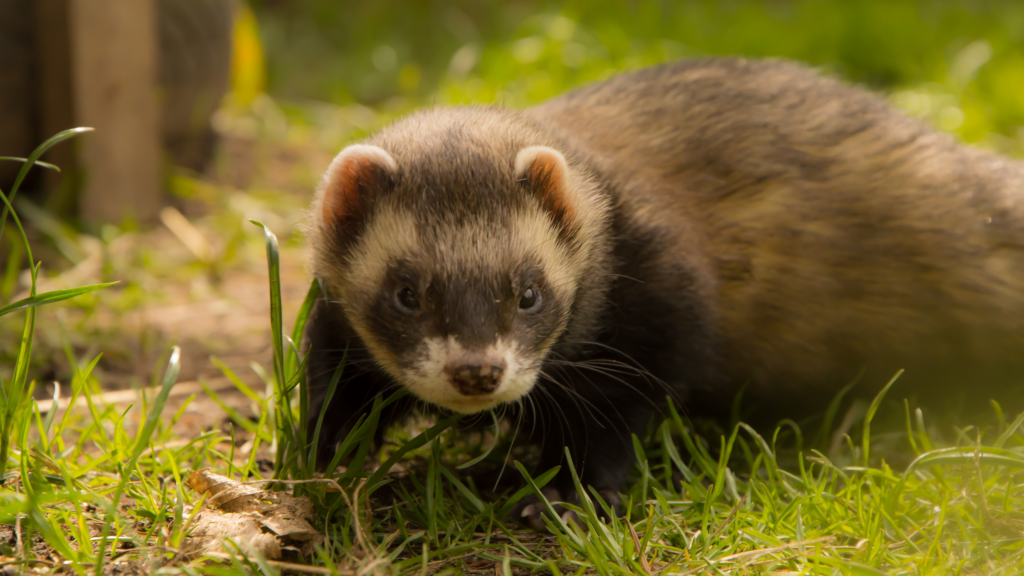
How to Choose the Right Ferret: Ferret Breeds and Colors Guide
Choosing a ferret is an exciting but important decision. While all ferrets share a playful and curious nature, their color, coat type, and body structure can influence factors like grooming needs and potential health risks. Some ferrets may require extra maintenance due to their long fur, while others might have specific genetic predispositions to consider. However, the most crucial factor is whether their personality aligns with your lifestyle. Let’s break down the key aspects to consider when selecting the perfect ferret for you.
Once you’ve decided on the perfect ferret, check out our Ferret Adoption and Care Guide for expert tips on bringing them home.
Personality vs. Appearance
It’s easy to fall in love with a ferret based on its adorable looks, but does color or body type affect personality? The short answer is no—coat color and markings have no scientific link to a ferret’s temperament. A black sable ferret won’t be more aggressive than a cinnamon one, and an albino won’t necessarily be more timid. However, some body types, such as whippet (slender) ferrets, tend to be more energetic and active, while bulkier European hybrids might be a little more independent.
Regardless of appearance, most ferrets exhibit similar personality traits: mischievous, playful, and social. Some are naturally more cuddly, while others are constantly on the move. The best way to determine temperament is to spend time with the ferret before adopting. Look for clues—does it eagerly engage with toys? Is it comfortable being handled? A ferret’s early experiences, socialization, and environment play a far greater role in behavior than appearance alone. So, instead of focusing on looks, choose a ferret that matches your energy level and lifestyle.
Care Requirements by Coat Type
A ferret’s coat type significantly impacts its grooming needs. Short-haired ferrets are the most common and easiest to maintain, only requiring occasional brushing to reduce shedding. They go through two major seasonal coat changes per year—shedding their thick winter fur in the spring and growing it back in the fall. This means you may notice extra fur around your home during these transitions, but a quick brush a few times a week can keep it under control.
Long-haired ferrets, such as Angoras, need more frequent grooming. Their luxurious fur is prone to tangling and matting, especially around their legs and belly. Without regular brushing, dirt, bedding, and even food can get caught in their coat, leading to discomfort. Angoras may also shed more frequently than short-haired ferrets, making them a bit more challenging for allergy-prone owners. Additionally, because their fur is longer, they require a high-protein diet to support healthy coat growth. If you’re considering a long-haired ferret, be prepared to spend extra time on grooming and maintenance to keep their coat in top condition.
Health Concerns for Specific Types
While all ferrets are susceptible to common health issues like adrenal disease and insulinoma, some coat colors and body types have higher risks for certain genetic conditions. Albino ferrets, for example, are more prone to vision and hearing impairments. Due to the lack of pigment in their eyes, they often have reduced depth perception, making them more cautious in unfamiliar environments. Many albino and blaze-patterned ferrets also have Waardenburg syndrome, a genetic condition that can cause partial or complete deafness.
European (hybrid) ferrets, due to their larger size, may have joint issues or mobility problems as they age. Their robust build requires a protein-rich diet to maintain muscle mass, and they may be more prone to obesity if not given enough exercise. On the other hand, whippet (slender) ferrets have a faster metabolism and require slightly more food to maintain a healthy weight.
No matter what type of ferret you choose, regular vet checkups, a high-quality diet, and plenty of exercise are the best ways to ensure a long and healthy life. By understanding the potential health risks associated with specific ferret types, you can make an informed decision and provide the best care for your new furry friend.
When choosing a ferret, don’t just go by looks—consider personality, coat care, and potential health concerns. If you’re considering a specific color, be mindful of any associated genetic conditions. The most important thing is finding a ferret whose temperament fits your lifestyle. After all, the bond you build with your ferret will matter far more than their appearance!
Some coat colors and body types may have higher health risks. Learn more in our Ferret Health Guide.
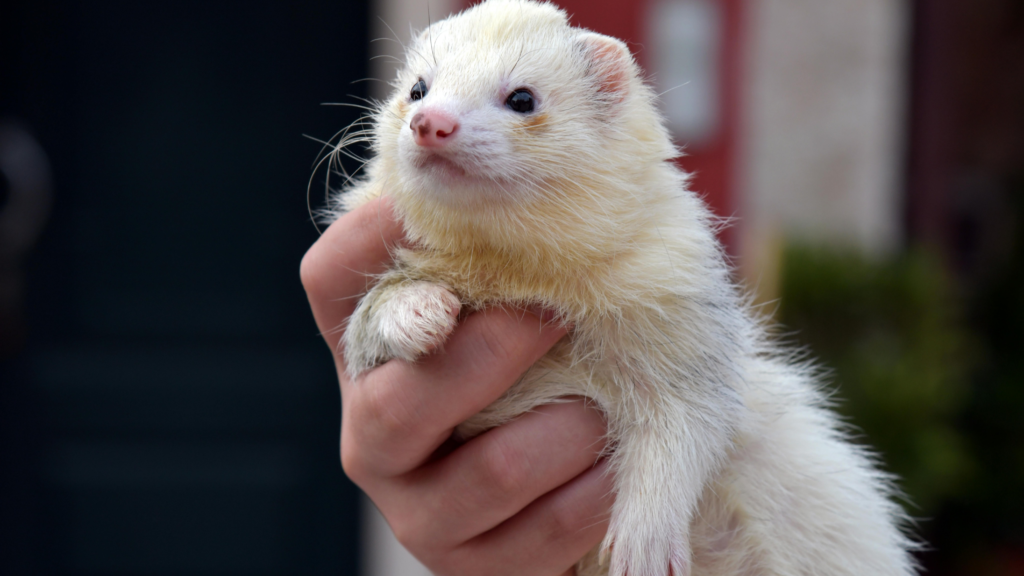
Myths and Misconceptions
Ferrets are fascinating, playful companions, but like many unique pets, they’re surrounded by myths and misconceptions. Some of these myths are harmless, while others can lead to misunderstandings about ferret care. Whether it’s questions about albino ferrets’ senses, the lifespan of different coat colors, or the trainability of hybrid ferrets, it’s time to separate fact from fiction. Let’s debunk some of the most common myths about ferrets!
Are Albino Ferrets Blind or Deaf?
One of the most persistent myths about albino ferrets is that they are completely blind or deaf. While it’s true that albino ferrets have weaker vision compared to darker-colored ferrets, they are not completely blind. Their red or pinkish eyes lack pigmentation, making them more sensitive to bright light, which can cause them to appear hesitant in well-lit areas. Some albino ferrets also have trouble with depth perception, which might make them seem clumsier than their dark-eyed counterparts. However, they can still see and navigate their environment, especially in dim lighting where their vision is most effective.
Deafness, on the other hand, is more common in albino and blaze-patterned ferrets due to a genetic condition known as Waardenburg syndrome. While not all albinos are deaf, many do have partial or complete hearing loss. Thankfully, this doesn’t affect their ability to be loving, playful pets. Deaf ferrets rely more on their sense of smell and vibrations to navigate the world. They can still learn commands through hand signals and touch-based communication, making them just as trainable as hearing ferrets!
Do Certain Ferret Colors Live Longer?
Some ferret owners believe that coat color determines lifespan, with rarer colors supposedly living longer or being healthier. However, ferret lifespan is not linked to fur color. On average, domestic ferrets live between 5 to 10 years, regardless of their coat shade. Their longevity depends more on genetics, diet, exercise, and overall healthcare than the color of their fur.
That said, some coat colors, particularly silver and panda ferrets, may fade over time due to genetic factors, but this has nothing to do with their lifespan. The biggest threat to a ferret’s longevity isn’t its color—it’s health conditions like adrenal disease, insulinoma, and lymphoma, which are unfortunately common in pet ferrets. To ensure a long, healthy life, focus on providing a balanced diet, regular vet checkups, and plenty of mental stimulation rather than worrying about fur color.
Are Hybrid Ferrets Harder to Train?
Hybrid ferrets—those that have been bred with European polecats—are often rumored to be more difficult to train than standard domesticated ferrets. While it’s true that European hybrids tend to have stronger survival instincts, this doesn’t mean they’re impossible to train. They may be more independent, cautious, or territorial compared to American ferrets, but with patience and proper socialization, they can become well-behaved pets.
One reason hybrids might be seen as “harder to train” is their higher intelligence and problem-solving skills. Unlike standard ferrets, which are usually eager to please, hybrids can be more stubborn and selective about following commands. They also have stronger bite inhibition, meaning they might nip more frequently if they feel threatened or overstimulated. However, with consistent positive reinforcement, patience, and early handling, even hybrid ferrets can learn litter training, commands, and social behaviors just like their domesticated cousins.
If you’re considering a hybrid ferret, be prepared to invest extra time in training and bonding. They thrive in environments where they have plenty of mental and physical enrichment, and they often do best with experienced owners who understand their unique needs. While they may require a little more effort, they can also be incredibly rewarding pets for those willing to put in the time.

Fun Facts About Ferret Breeds and Colors
Ferrets are fascinating creatures, and the diversity in ferret breeds and colors means there’s always something new to discover about them. While all domesticated ferrets belong to the same species (Mustela putorius furo), centuries of selective breeding have created a diverse range of appearances. From rare coat colors to unique physical traits, there’s always something new to learn about these playful little animals. Let’s dive into some of the most intriguing facts about ferret varieties!
The Rarest Ferret Colors in the World
Among ferret breeds and colors, some variations are much rarer and highly sought after by enthusiasts. Cinnamon ferrets, with their warm reddish-brown coats, are among the rarest, often sought after by enthusiasts for their striking appearance. True black ferrets—which have deep, almost jet-black fur without any brown undertones—are also uncommon and highly prized.
Another rare variation is the silver ferret, which starts with a beautiful silver-gray coat but often fades to white over time. This color change occurs due to genetics, making it tricky to maintain a true silver hue throughout a ferret’s life. Marked white ferrets—which have an all-white coat with subtle markings—are another unique variety, but they are often linked to Waardenburg syndrome, a condition that can cause deafness. If you come across one of these rare colorations, you’re looking at a truly special ferret!
The History of Ferret Breeding and Domestication
Ferrets have a long history of domestication that dates back over 2,500 years. Ancient civilizations, including the Romans and Egyptians, used ferrets for hunting and pest control. Their slender bodies and quick reflexes made them excellent for flushing out rodents and rabbits from burrows. In fact, the word “ferret” comes from the Latin word furittus, meaning “little thief”—a fitting name given their mischievous nature!
Over time, ferrets became more than just working animals. By the Middle Ages, they were kept as exotic pets by European royalty. It wasn’t until the 20th century that ferrets became widely available as household pets, especially in North America. During this period, breeders began selectively breeding ferrets for different coat colors, patterns, and body types, leading to the variety we see today. While some ferrets are still used for hunting in certain parts of the world, most are now beloved companions, known for their playful and affectionate personalities.
Ferrets with Unique Physical Traits
Beyond their colors and patterns, some ferrets have distinctive physical traits that set them apart. One of the most fascinating variations is the Angora ferret, known for its extra-long, silky fur. Unlike standard ferrets, Angoras have no undercoat, which makes their fur feel softer and fluffier. However, their long hair requires extra grooming to prevent matting.
Another unusual trait is seen in whippet ferrets, which have a longer, leaner body than the average ferret. These ferrets are built for speed and agility, often appearing more energetic and hyperactive than their stockier counterparts.
Then there’s the panda ferret, which has a distinctive white head and dark body markings, making it resemble a tiny panda bear. Panda and blaze-patterned ferrets also have a high likelihood of being deaf due to Waardenburg syndrome, but this doesn’t affect their ability to live happy, playful lives.
Ferrets are full of surprises, and their unique features only add to their charm. Whether you have a standard sable, a rare silver, or a long-haired Angora, every ferret is special in its own way!
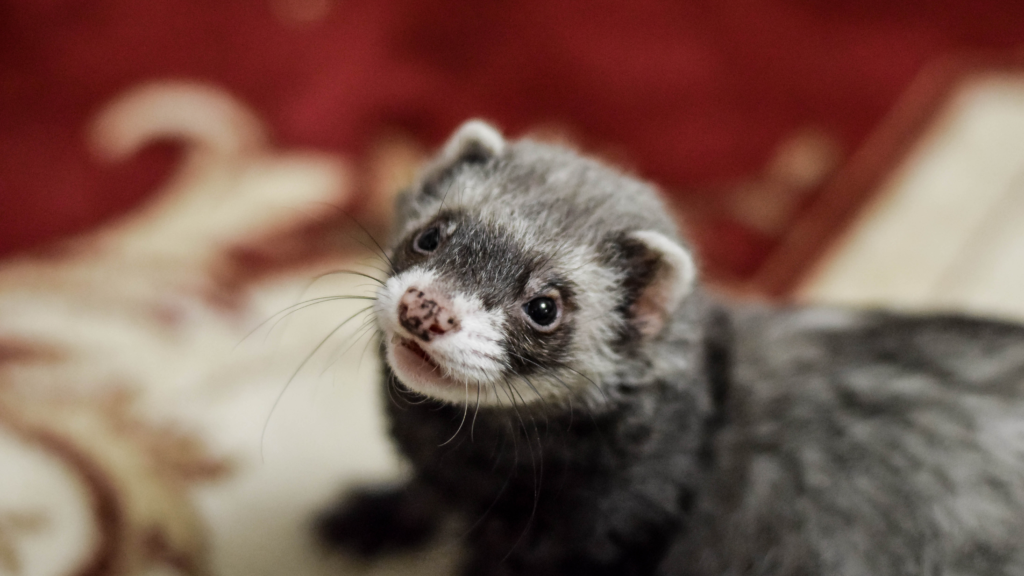
Which Ferret Type Is Right for You?
No matter the variation in ferret breeds and colors, all ferrets share the same mischievous, energetic, and affectionate personality that makes them such wonderful pets. Whether you’re drawn to the sleek elegance of a black sable ferret, the fluffy charm of an Angora, or the unique markings of a panda ferret, their appearance is just one part of the equation. Regardless of the variation in ferret breeds and colors, the most important factor is providing a loving and enriching home.
Before adopting a ferret, take time to research their care requirements, behavior, and daily routines. Some ferrets, like long-haired Angoras, require more grooming, while hybrids may have a stronger independent streak. Others, like slender whippet ferrets, tend to be more active and require extra playtime. Understanding these differences will help you find a ferret that fits your lifestyle and experience level.
Regardless of the diversity in ferret breeds and colors, ferrets thrive in homes with plenty of stimulation, a proper diet, and regular vet care. If you’re willing to put in the effort, you’ll be rewarded with a loyal, entertaining, and endlessly curious companion. No matter which ferret type you choose, the bond you build with them will be what truly matters.
Before bringing a ferret home, make sure you understand their daily needs by checking out The Ultimate Ferret Care Guide.

